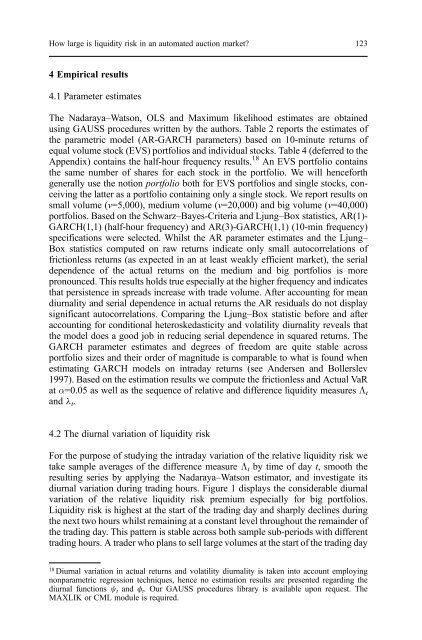recent developments in high frequency financial ... - Index of
recent developments in high frequency financial ... - Index of
recent developments in high frequency financial ... - Index of
You also want an ePaper? Increase the reach of your titles
YUMPU automatically turns print PDFs into web optimized ePapers that Google loves.
How large is liquidity risk <strong>in</strong> an automated auction market? 123<br />
4 Empirical results<br />
4.1 Parameter estimates<br />
The Nadaraya–Watson, OLS and Maximum likelihood estimates are obta<strong>in</strong>ed<br />
us<strong>in</strong>g GAUSS procedures written by the authors. Table 2 reports the estimates <strong>of</strong><br />
the parametric model (AR-GARCH parameters) based on 10-m<strong>in</strong>ute returns <strong>of</strong><br />
equal volume stock (EVS) portfolios and <strong>in</strong>dividual stocks. Table 4 (deferred to the<br />
Appendix) conta<strong>in</strong>s the half-hour <strong>frequency</strong> results. 18 An EVS portfolio conta<strong>in</strong>s<br />
the same number <strong>of</strong> shares for each stock <strong>in</strong> the portfolio. We will henceforth<br />
generally use the notion portfolio both for EVS portfolios and s<strong>in</strong>gle stocks, conceiv<strong>in</strong>g<br />
the latter as a portfolio conta<strong>in</strong><strong>in</strong>g only a s<strong>in</strong>gle stock. We report results on<br />
small volume (v=5,000), medium volume (v=20,000) and big volume (v=40,000)<br />
portfolios. Based on the Schwarz–Bayes-Criteria and Ljung–Box statistics, AR(1)-<br />
GARCH(1,1) (half-hour <strong>frequency</strong>) and AR(3)-GARCH(1,1) (10-m<strong>in</strong> <strong>frequency</strong>)<br />
specifications were selected. Whilst the AR parameter estimates and the Ljung–<br />
Box statistics computed on raw returns <strong>in</strong>dicate only small autocorrelations <strong>of</strong><br />
frictionless returns (as expected <strong>in</strong> an at least weakly efficient market), the serial<br />
dependence <strong>of</strong> the actual returns on the medium and big portfolios is more<br />
pronounced. This results holds true especially at the <strong>high</strong>er <strong>frequency</strong> and <strong>in</strong>dicates<br />
that persistence <strong>in</strong> spreads <strong>in</strong>crease with trade volume. After account<strong>in</strong>g for mean<br />
diurnality and serial dependence <strong>in</strong> actual returns the AR residuals do not display<br />
significant autocorrelations. Compar<strong>in</strong>g the Ljung–Box statistic before and after<br />
account<strong>in</strong>g for conditional heteroskedasticity and volatility diurnality reveals that<br />
the model does a good job <strong>in</strong> reduc<strong>in</strong>g serial dependence <strong>in</strong> squared returns. The<br />
GARCH parameter estimates and degrees <strong>of</strong> freedom are quite stable across<br />
portfolio sizes and their order <strong>of</strong> magnitude is comparable to what is found when<br />
estimat<strong>in</strong>g GARCH models on <strong>in</strong>traday returns (see Andersen and Bollerslev<br />
1997). Based on the estimation results we compute the frictionless and Actual VaR<br />
at α=0.05 as well as the sequence <strong>of</strong> relative and difference liquidity measures Λt<br />
and t.<br />
4.2 The diurnal variation <strong>of</strong> liquidity risk<br />
For the purpose <strong>of</strong> study<strong>in</strong>g the <strong>in</strong>traday variation <strong>of</strong> the relative liquidity risk we<br />
take sample averages <strong>of</strong> the difference measure Λ t by time <strong>of</strong> day t, smooth the<br />
result<strong>in</strong>g series by apply<strong>in</strong>g the Nadaraya–Watson estimator, and <strong>in</strong>vestigate its<br />
diurnal variation dur<strong>in</strong>g trad<strong>in</strong>g hours. Figure 1 displays the considerable diurnal<br />
variation <strong>of</strong> the relative liquidity risk premium especially for big portfolios.<br />
Liquidity risk is <strong>high</strong>est at the start <strong>of</strong> the trad<strong>in</strong>g day and sharply decl<strong>in</strong>es dur<strong>in</strong>g<br />
the next two hours whilst rema<strong>in</strong><strong>in</strong>g at a constant level throughout the rema<strong>in</strong>der <strong>of</strong><br />
the trad<strong>in</strong>g day. This pattern is stable across both sample sub-periods with different<br />
trad<strong>in</strong>g hours. A trader who plans to sell large volumes at the start <strong>of</strong> the trad<strong>in</strong>g day<br />
18 Diurnal variation <strong>in</strong> actual returns and volatility diurnality is taken <strong>in</strong>to account employ<strong>in</strong>g<br />
nonparametric regression techniques, hence no estimation results are presented regard<strong>in</strong>g the<br />
diurnal functions t and t. Our GAUSS procedures library is available upon request. The<br />
MAXLIK or CML module is required.










